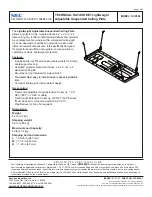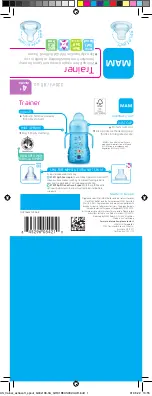
18
GAZELLE MANUAL
18
Bicycle Owner’s Manual
1. Brake controls and features
It’s very important to your safety
that you learn and remember
which brake lever controls which
brake on your bike. Traditionally,
in the U.S. the right brake lever
controls the rear brake and the
left brake lever controls the
front brake; but, to check how
your bike’s brakes are set up,
squeeze one brake lever and look
to see which brake, front or rear,
engages. Now do the same with
the other brake lever.
Make sure that your hands
can reach and squeeze the brake
levers comfortably. If your hands
are too small to operate the
levers comfortably, consult your
dealer before riding the bike. The
lever reach may be adjustable; or
you may need a different brake
lever design.
Most rim brakes have some form of quick-release
mechanism to allow the brake pads to clear the tire when
a wheel is removed or
reinstalled. When the brake
quick release is in the open
position, the brakes are
inoperative. Ask your dealer to
make sure that you understand
the way the brake quick release
works on your bike (see figs. 12,
13. 14 & 15) and check each time
to make sure both brakes work
correctly before you get on the
bike.
2. How brakes work
The braking action of a bicycle
is a function of the friction
between the braking surfaces.
To make sure that you have
maximum friction available, keep your wheel rims and
brake pads or the disk rotor and caliper clean and free of
dirt, lubricants, waxes or polishes.
Brakes are designed to control your speed, not just
to stop the bike. Maximum braking force for each wheel
occurs at the point just before the wheel “locks up”
(stops rotating) and starts to skid. Once the tire skids,
you actually lose most of your stopping force and all
directional control. You need to practice slowing and
stopping smoothly without locking up a wheel. The
technique is called progressive brake modulation. Instead
of jerking the brake lever to the position where you think
you’ll generate appropriate braking force, squeeze the
lever, progressively increasing the braking force. If you
feel the wheel begin to lock up, release pressure just a
little to keep the wheel rotating just short of lockup. It’s
important to develop a feel for the amount of brake lever
pressure required for each wheel at different speeds
and on different surfaces. To better understand this,
experiment a little by walking your bike and applying
different amounts of pressure to each brake lever, until
the wheel locks.
When you apply one or both brakes, the bike begins
to slow, but your body wants to continue at the speed
at which it was going. This causes a transfer of weight
to the front wheel (or, under heavy braking, around the
front wheel hub, which could send you flying over the
handlebars).
A wheel with more weight on it will accept greater
brake pressure before lockup; a wheel with less weight
will lock up with less brake pressure. So, as you apply
brakes and your weight is transferred forward, you need
to shift your body toward the rear of the bike, to transfer
weight back on to the rear wheel; and at the same time,
you need to both decrease rear braking and increase front
braking force. This is even more important on descents,
because descents shift weight forward.
Two keys to effective speed control and safe stopping
are controlling wheel lockup and weight transfer. This
weight transfer is even more pronounced if your bike has
a front suspension fork. Front suspension “dips” under
braking, increasing the weight transfer (see also Section
4.F). Practice braking and weight transfer techniques
where there is no traffic or other hazards and distractions.
Everything changes when you ride on loose surfaces
or in wet weather. It will take longer to stop on loose
surfaces or in wet weather. Tire adhesion is reduced, so
the wheels have less cornering and braking traction and
can lock up with less brake force. Moisture or dirt on
the brake pads reduces their ability to grip. The way to
maintain control on loose or wet surfaces is to go more
slowly.
D. Shifting gears
Your multi-speed bicycle will have a derailleur
drivetrain (see 1. below), an internal gear hub drivetrain
(see 2. below) or, in some special cases, a combination of
the two.
1. How a derailleur drivetrain works
If your bicycle has a derailleur drivetrain, the gear-
changing mechanism will have:
• a rear cassette or freewheel sprocket cluster
• a rear derailleur
• usually a front derailleur
• one or two shifters
• one, two or three front sprockets called chainrings
• a drive chain
















































